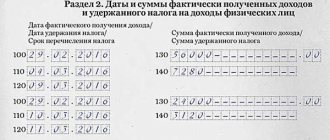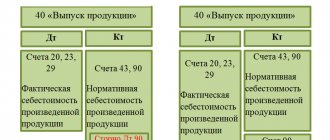How to organize accounting
The chart of accounts (Order of the Ministry of Finance No. 94n dated October 31, 2000) provides account 70 “Settlements with personnel for wages” to reflect accruals and payment of wages and deductions from it. Postings are generated using it when accruing salary in correspondence with other accounts. The account is passive, and its loan balance reflects the amount of wages the organization owes to its employees. The credit of the account reflects the accrual of fees for performing labor duties. The debit reflects a transfer from a current account or a posting for the payment of wages from the cash register, reflecting the amount of deductions.
Analytical accounting should be organized for each employee separately. This will allow you to receive up-to-date information on accruals and debts for each individual employee of the company at any time.
The main stages of organizing payroll accounting include:
- Calculation of wages.
- Calculation and accounting of deductions from salaries.
- Calculation of insurance premiums.
- Payment of wages.
- Transfer of personal income tax and insurance premiums.
The accountant repeats all stages every month, and individual entries are generated for each case. We will describe in detail everything an accountant needs to know in 2021 about the correspondence of accounts that are used most often.
ConsultantPlus experts examined how to reflect in accounting the wages overpaid upon dismissal of an employee, and the corresponding amounts of personal income tax and insurance contributions. Use these instructions for free.
Posting accrued wages to workers for production
- The debit reflects the withholding of personal income tax, previously called income tax, amounts to pension and other social funds, other withholdings - alimony, fines, payment of loans and utilities by transfer according to the application of the employee.
Postings on vacations What typical accounting entries need to be made to reflect the employee's vacation in accounting. Calculation and payment of vacation benefits. 1 Postings for the accrual and payment of financial assistance to an employee How the payment of financial assistance to an individual employee of an organization is reflected in accounting.
How to reflect in accounting
The accrual of wages is reflected in the credit of account 70. Corresponding accounts when calculating wages reflect the direction of cost accounting depending on the labor functions performed by the employee. Also, the credit of account 70 reflects the accrual of fees for the time the employee is absent due to illness or vacation.
| Debit | Credit | |
| Posting of payroll for employees of main production | 20 | 70 |
| Workers of auxiliary production | 23 | 70 |
| Employees of departments serving the main production | 25 | 70 |
| Posting payroll to management personnel | 26 | 70 |
| The construction work of the new administrative building is being carried out on our own. | 08 | 70 |
| Calculated salaries of employees of a trade organization | 44 | 70 |
| Calculated payment for certificates of incapacity for work at the expense of the employer (the first three days) | 20, 25, 26, 44 | 70 |
| Calculated payment for certificates of incapacity for work at the expense of the Social Insurance Fund | 69 | 70 |
| Reflects accrued payments that are not directly related to work activities (for example, an employee’s anniversary bonus) | 91 | 70 |
| If a reserve is formed for vacation pay | ||
| A deduction was made to the reserve on the date when wages were accrued | 20, 25, 26, 44 | 96 |
| Vacation pay accrued | 96 | 70 |
Accounting for public sector employees
To reflect the amounts of accrued remuneration for the work of employees of public sector institutions, separate accounting instructions should be applied. In other words, the general Chart of Accounts (Order No. 94n) cannot be applied in this case.
General instructions for organizations are Order of the Ministry of Finance No. 157n. But this is not the only document. Additional recommendations and requirements are given in separate orders:
- Instruction No. 174n - for budgetary institutions.
- Instruction No. 183n - for autonomous organizations.
- Instruction No. 162n - for government-type government agencies.
To keep track of salaries in budgetary institutions in 2021, state employees are required to use account 0 302 10 000 “Calculations for wages and accruals for wage payments.”
To organize reliable synthetic accounting, it is necessary to detail the information. To do this, provide the appropriate analytical accounting codes:
- Code “1” or 0 302 11 000 - is intended to reflect operations for directly calculating wages. For example, on this accounting account reflect the accrued salary, incentives, and compensation payments. If a territorial (district) coefficient is applied to earnings, then reflect these amounts with code “1”. Also include in the group the amounts of accrued vacation pay and sick leave benefits at the expense of the employer.
- Code “2” or 0 302 12 000 - information on other payments in favor of employees is accumulated. For example, this group includes accruals in favor of women receiving benefits for children under three years of age. Currently, the amount of such payment is 50 rubles. If there is a regional coefficient in your region, then include it in the group with code “2”.
- Code “3” or 0 302 13 000 - this group includes all calculations for calculating benefits for illness, pregnancy and childbirth, one-time payments from the Social Insurance Fund. That is, code “3” is intended to reflect charges for wage payments.
The accrual of labor costs is reflected in the credit of account 0 302 00 000, in correspondence with the accounts:
- 0 109 00 000 - when reflecting payments in favor of employees directly involved in the implementation of municipal tasks;
- 0 401 20 000 - for calculating payments to other personnel.
Salary deductions
Deductions from wages are reflected in the debit of account 70. The main ones are:
- personal income tax;
- alimony, other deductions under writs of execution;
- contributions to a trade union organization;
- compensation to the enterprise for damage or loss.
| Debit | Credit | |
| Personal income tax calculated | 70 | 68 |
| Payments under writs of execution (alimony, fines) are withheld | 70 | 76 |
| Amounts of compensation for shortages and damages due to the fault of the employee are withheld | 70 | 73 |
| Upon dismissal, payment for unworked vacation days is withheld, reversal | 96 (20, 25, 26, 44) | 70 |
Read more: Calculation and withholding of alimony
Accrued wages to workers for production of products posting
Analytical accounting for account 28 “Defects in production” is carried out for individual divisions of the organization, types of products, expense items, causes and culprits of defects. In the debit of account 28 “Defects in production”, costs are collected for identified internal and external defects (cost of irreparable, i.e. final, defects, costs of correcting defects, etc.). The credit of account 28 “Defects in production” reflects the amounts attributable to reducing losses from defects: By comparing the debit and credit entries of account 28 “Defects in production”, losses from defects are determined, which are written off monthly to the costs of main or auxiliary production. Task 8.5.1 According to notices of defects, parts were rejected in the organization’s machine shop.
Postings for wages 4 Postings for deduction for unworked vacation days upon dismissal In settlements with employees of an enterprise, a situation is often encountered when an employee who took vacation in advance is fired.
We recommend reading: Benefits for labor veterans in medical institutions in Ugra
Payment of wages
Salaries, at the employee’s request, are issued to him in cash or by bank transfer. Regardless of whether it is transferred to the card or issued from the cash register, the posting of paid wages is generated by the debit of account 70.
| Debit | Credit | |
| Salaries were paid from the bank account to employee cards | 70 | 51 |
| Salary posting issued from cash register | 70 | 50 |
| Alimony and other deductions under writs of execution have been paid | 76 | 51 |
Wages accrued to workers of main production
According to the Tax Code of the Russian Federation, the income of every citizen is subject to mandatory payments. Employees do not prepare declarations or make independent transfers; this is the responsibility of employers. Financiers of enterprises carry out accounting with appropriate reflection in postings.
- The debit reflects the withholding of personal income tax, previously called income tax, amounts to pension and other social funds, other withholdings - alimony, fines, payment of loans and utilities by transfer according to the application of the employee. It also contains the amount to be paid, which is entered into a special statement.
- The credit side is formed from accruals that contain amounts for salary, tariff, allowances and bonuses in accordance with the data of the provided time sheet. No. T – 12 or tariff scale.
- Accruals and deductions are recorded for each employee individually:
Personal income tax and insurance premiums: calculation and payment
From payments to employees, employers are required to calculate and transfer to the state:
- personal income tax (the rate for residents is 13% on incomes not exceeding 5 million rubles, 15% on higher incomes);
- insurance premiums (22% - OPS, 5.1% - Compulsory Medical Insurance, 2.9% - OSS).
IMPORTANT!
For 2021, reduced rates of insurance premiums for small and medium-sized businesses have been retained: 10% - compulsory insurance, 5% - compulsory medical insurance, 0% - compulsory insurance for payments exceeding the minimum wage.
To generate entries for accounting tax payments, the chart of accounts provides account 68, and for the calculation and accounting of insurance premiums - account 69.
| Debit | Credit | |
| Personal income tax calculated | 70 | 68 |
| Insurance premiums have been calculated | 20, 23, 25, 26, 44 | 69 |
| The withheld personal income tax was transferred to the budget | 68 | 51 |
| Insurance premiums transferred to the budget | 69 | 51 |
Read more: Deadlines for personal income tax payment
Read more: Basic information about insurance premiums
Advances received
When an organization sells goods, works or services, the buyer can make an advance payment before the moment of sale.
According to the requirements of the Tax Code, the seller is obliged to charge VAT on the advance received. VAT is calculated using the formula:
VAT on the advance received = Sales amount *18/100
Example
Let's consider the previous example from the point of view of the selling organization, that is. VAT is charged on the advance payment at the time of its receipt; the amount of such VAT is reimbursed to the budget at the end of the tax period - quarter.
VAT on sales is accrued at the time of shipment, that is, at the time the sales transaction is created Dt 62 - Kt 90.1 .
Advances received - postings
When receiving an advance from a buyer, the accountant makes the following entries:
| Dt | CT | Operation description | Sum | Document |
| 51 | 62.2 | Advance received from buyer (including VAT) | 23 600 | Payment order in. |
| 76(advances) | 68 | VAT accrual on advance payment | 3 600 | Invoice issued, accounting certificate |
| 62.1 | 90.1 | Sales revenue accrued | 23 600 | Sales certificate, invoice |
| 90(VAT) | 68 | VAT on sales | 3 600 | SF issued, accounting certificate |
| 68 | 76(advances) | Accepted for deduction of VAT on advances (after sale) | 3 600 | Book of purchases |
Reflection of PO transactions in accounting registers
Forms of registers for recording business transactions are developed and approved by a commercial organization independently. They must ensure that they can obtain up-to-date information about the company's assets and liabilities at any time.
As mentioned above, the payroll accounting register is required to provide detailed data for each employee. It is also advisable to detail the data on the types and amounts of charges, deductions and payments. Such detailed accounting is organized in an independently developed form or using the T-54 form, approved by the State Statistics Committee in Resolution No. 1 of 01/05/2004. The basis for calculating wages and filling out registers for its accounting are:
- time sheets;
- employment contracts;
- bonus orders;
- vacation orders;
- writs of execution and statements of deductions;
- other documents on labor standards and remuneration.
Form T-54
Also, according to Article 136 of the Labor Code of the Russian Federation, the employer is obliged to notify staff about accruals and deductions before transferring wages. This can be done by issuing a pay slip to the employee. Its form should be clear and allow the employee to know about accruals, deductions and amounts to be received. The organization has the right to inform an employee both on paper and in electronic form, for example by sending a payslip by email.
Pay slip form:
Read more: Procedure and deadlines for issuing pay slips
Payroll for employees: accounting entries
The latter is especially common. An employer can promise a subordinate mountains of gold; as a result, he will pay pennies, or even not pay at all. In the absence of documentary evidence, it is almost impossible to prove a violation of an employee’s rights.
We recommend reading: Sample certificate of no criminal record for educators
True, it is worth considering: not always the funds received, for example, from the sale of products of the main production, have a positive effect on the volume of payment and incentives for workers. In labor practice, there are many examples when the calculation of wages and other payments to employees is affected only by the unsatisfactory financial and economic condition of the enterprise (when the calculation and posting of accruals is delayed or is not carried out in full).
Accrual example: calculation and postings
Let's look at an example of the procedure for generating entries for debt to an employee for accrued remuneration for wages for work and its payment. LLC "Company" employs two people. The organization is engaged in wholesale trade, and wage entries for the director and all other employees are generated and assigned to account 44. Salaries are paid on the 10th of the next month. On the same day, personal income tax and alimony are transferred. Insurance premiums were transferred on December 14, 2020.
Manager Petrov P.P. pays alimony according to the writ of execution - 25% of the salary. Everyone is tax residents, that is, the personal income tax rate for everyone is set at 13%. The organization pays insurance premiums at regular rates (22% - OPS, 5.1% - Compulsory Medical Insurance, 2.9% - OSS). All employees are paid salaries via bank cards.
| FULL NAME. | Job title | Accrued based on salary | Sickness benefit (all payment at the expense of the Social Insurance Fund) | Personal income tax | Alimony | To payoff | Insurance premiums | ||
| OPS | Compulsory medical insurance | OSS | |||||||
| Ivanov I.I. | Director | 40 000 | 10 000 | 6 500 | 43 500 | 8 800 | 2 040 | 1 160 | |
| Petrov P.P. | Manager | 30 000 | 3 900 | 6 525 | 19 575 | 6 600 | 1 530 | 870 | |
| Total | 70 000 | 10 000 | 10 400 | 6 525 | 63 075 | 15 400 | 3 570 | 2 030 | |
The accountant will generate the following accounting records:
Entries for payroll and taxes for January 2021
| Sum | Debit | Credit | |
| January 31, 2021 | |||
| Salary accrued | 70 000 | 44 | 70 |
| Disability benefits | 10 000 | 69 | 70 |
| Personal income tax withheld | 10 400 | 70 | 68 |
| Child support withheld | 6 525 | 70 | 76 |
| Insurance premiums accrued (15,400 + 3,570 + 2,030) | 21 000 | 44 | 69 |
| February 10, 2021 | |||
| Salary paid | 63 075 | 70 | 51 |
| Alimony payments listed | 6 525 | 76 | 51 |
| Personal income tax paid to the budget | 10 400 | 68 | 51 |
| February 15, 2021 | |||
| Insurance premiums listed | 21 000 | 69 | 51 |
Salary accounting in a budgetary institution
We collected in the table the entries for payroll in a budgetary institution in 2021.
| Contents of operation | Debit | Credit | Note |
| Salary accrued | 4 401 20 211 | 4 302 11 730 | Remuneration - KVR 111 Other payments - 112 Benefits and sick leave and insurance premiums - 119 |
| Accrual of sick leave | 4 401 20 213 | 4 302 13 730 | |
| Accrual of other payments | 4 401 20 212 | 4 302 12 730 | |
| Wages accrued to employees of main production, posting | 4 109 61 211 (if the salary is included in the cost) 4 109 71 211 (overheads) 4 109 81 211 (general business expenses) | 4 302 11 730 | |
| Personal income tax withheld | 4 302 11 830 | 4 303 01 730 | |
| Writ of execution withheld | 4 302 11 830 | 4 304 03 730 | |
| Salaries issued from the cash register, posting | 4 302 11 830 | 4 201 34 610 | |
| Transfer to bank cards | 4 302 11 830 | 4 201 11 610 | |
| Unpaid salary deposited | 4 302 11 830 | 4 304 02 730 | |
| Insurance premiums | 4 402 20 213 | 4 303 02 730 (FSS - 2.9%) 4 303 06 730 (FSS NS and PZ - 0.2%) 4 303 07 730 (FFOMS - 5.1%) 4,303 10,730 (OPS - 22%) |
Salary postings
Payroll entries are operations related to payroll calculation: accountants consider them to be a rather complex accounting procedure that requires the ability to correctly classify employee income and determine taxable bases for personal income tax and insurance premiums.
ConsultantPlus FREE for 3 days
Get access
The article discusses the accounting rules for the main stages of salary calculation: accrual, deduction, payment. We will also determine the procedure for calculating insurance premiums.
Basic provisions
Salary accounting entries are formed in accordance with the chart of accounts and the order on accounting policies. The chart of accounts for accounting for salary transactions provides for account 70, but the corresponding accounts may be different, depending on the type of activity:
- Dt 20 Kt 70 - wages of production workers;
- Dt 25 Kt 70 - wages of general production personnel;
- Dt 26 Kt 70 - salary of management personnel;
- Dt 44 Kt 70 - salary of the commercial department, sales department.
It must be remembered that entries for salary are always associated with the calculation of personal income tax - personal income tax, since organizations are tax agents and are required to withhold personal income tax from all payments to employees. The amounts accrued under the credit of account 70 must be comparable to the personal income tax accrued for the same period (Dt 70 Kt 68.01).
Payment of income to employees is made minus personal income tax and other deductions, if any, and is always reflected in the debit of account 70.
When paying wages from the cash register, the posting will be Dt 70 Kt 50. And when transferring wages to the employees’ bank card, the following correspondence of accounts is generated: Dt 70 Kt 51.
Payroll entries
General rules for generating payroll entries:
- wages to employees, the posting will always be in correspondence with the credit account. 70;
- Salary for employees of the main production, the posting should be on the debit of the account in which expenses for the main activity are recorded;
- Salary, entry for loan 70 shows the total accrual amount, including personal income tax;
- wages, posting always has the date of the last day of the month.
There are many nuances that complement the basic rules.
For example, accounting can take into account in account 70 not only salary, but also all taxable income of employees. In this case, when the salary is accrued, the posting includes not only wages, but also other income of the employee for the billing month, such as sick leave, vacation pay, bonuses, financial assistance, gifts, etc.
Deduction from wages: postings
The general rule when creating entries for deduction from salary is that the amount of deduction is always reflected in the debit of the account. 70 regardless of its type:
- Dt 70 Kt 68.01 - personal income tax withheld;
- Dt 70 Kt 76 - withheld according to a writ of execution;
- Dt 70 Kt 73.01 - the employee’s debt on the loan issued is withheld;
- Dt 70 Kt 73.02 - withheld to compensate for material damage caused by an employee.
There can be many types of deductions and each requires a document giving the accountant the basis for the deduction.
Such documents include writs of execution, employee statements or accounting calculations used in cases established by law. An accounting certificate will be needed when calculating personal income tax on material benefits and on income paid in kind.
Wages paid: posting
We list the general rules for generating salary payment transactions:
- wages issued: always on the debit of the account. 70;
- wages issued from the cash register: always on account credit. 50.
Typical salary invoice correspondence:
- salary is transferred to the employee’s bank card: Dt 70 Kt 51;
- PO issued from the cash desk: Dt 70 Kt 50.
We calculate insurance premiums
Income tax is not the only fiscal payment that applies to staff income. For most payments to employees, the employer is required to accrue and pay insurance coverage.
Let us remind you that starting from 2021, the procedure for calculating and paying insurance coverage is regulated by Chapter 34 of the Tax Code of the Russian Federation. Now these budget payments should be transferred to the Federal Tax Service. The transfer rules have also changed.
Thus, the payment order should indicate new BCCs, the recipient has changed (previously extra-budgetary funds, now the Federal Tax Service), filling in the payer status (field 101) has also been adjusted.
Read more in the article “Procedure for filling out payment orders for payment of insurance premiums in 2021.”
Thus, insurance premiums should be charged on wages for:
- compulsory pension insurance;
- compulsory health insurance;
- contributions for temporary disability and maternity.
But the procedure for calculating insurance premiums for accidents and occupational diseases has not changed. Pay these payments to the Social Insurance Fund. Fill out payment orders according to the old rules.
Accumulate all accrued contributions in account 69 “Calculations for social insurance and security.” Moreover, distribute the calculations by type of insurance coverage. Provide separate subaccounts for each type:
- 69.1 - calculations for social insurance;
- 69.2 - calculations for pension provision;
- 69.3 - amounts for compulsory medical insurance;
- 69.11 or 69.1/1 - payments for tax and income taxes.
Posting for the calculation of insurance premiums: Dt 70 Kt 69 (turnover in the corresponding subaccount).
Contributions have been paid to the appropriate budget: Dt 69 Kt 51.
Terms of payment of earnings
Employers are required to promptly transfer earnings to their employees. Thus, officials determined that, within the framework of labor relations, the employer is obliged to make payments at least twice in the reporting period. That is, all earnings due must be divided into two parts: salary for the first half of the month and the final payment.
Moreover, individual deadlines have been approved for each category of payments. The standards are enshrined in Part 6 of Art. 136 Labor Code of the Russian Federation:
- Pay the advance or earnings for the first half of the month no later than the 30th or 31st day of the month for which the payment is made.
- Pay the final payment to employees no later than the 15th day of the month following the settlement month.
Source: https://ppt.ru/art/buh-uchet/nachislena-zp









